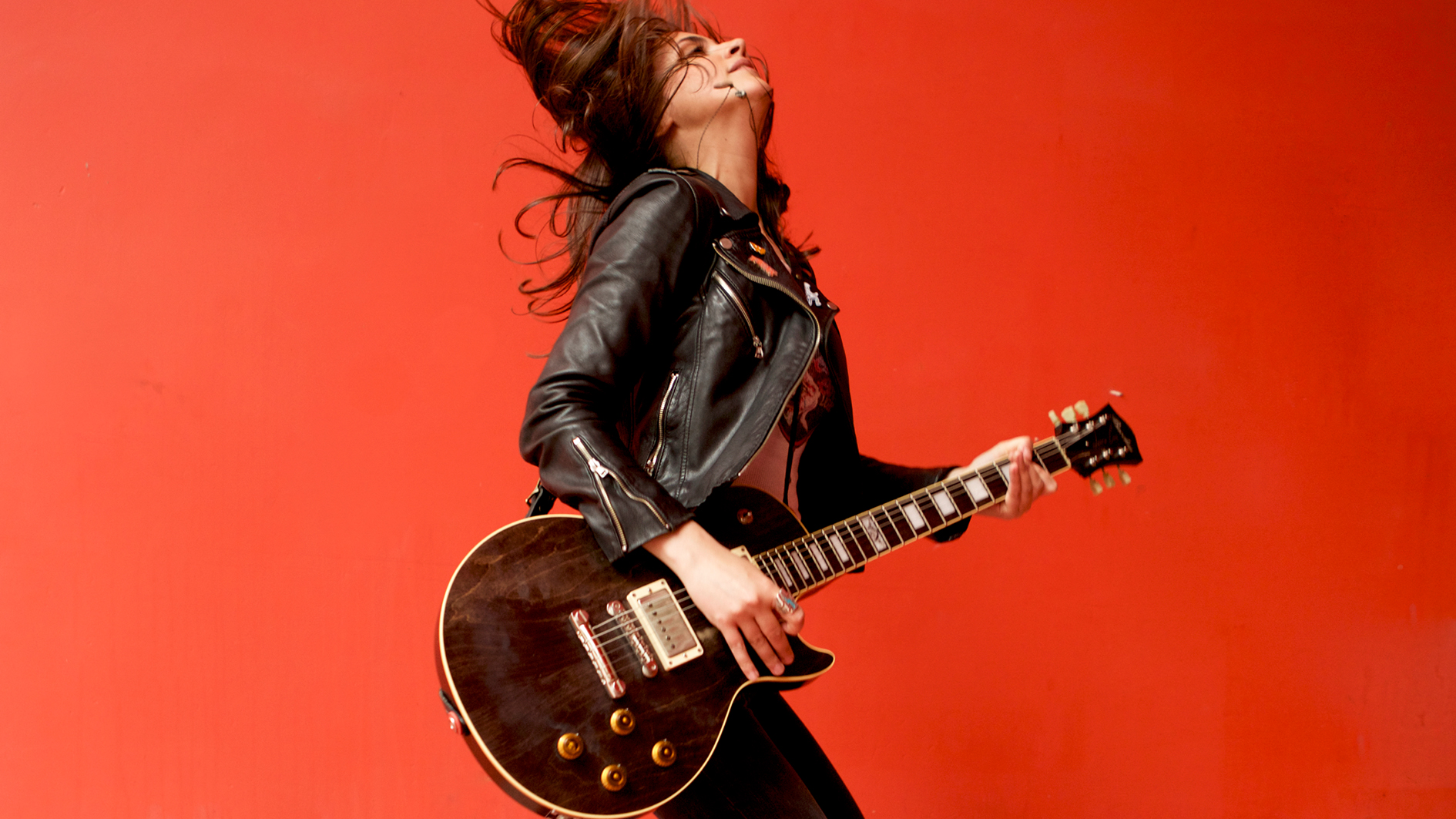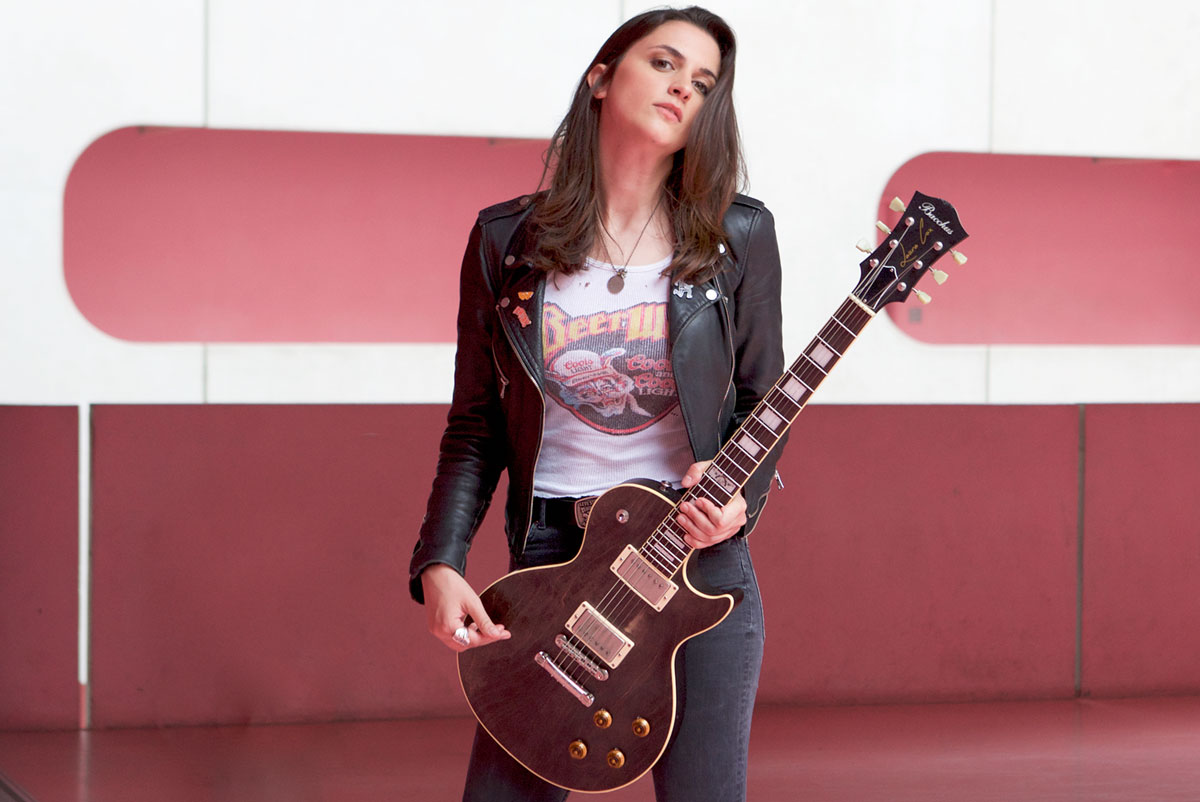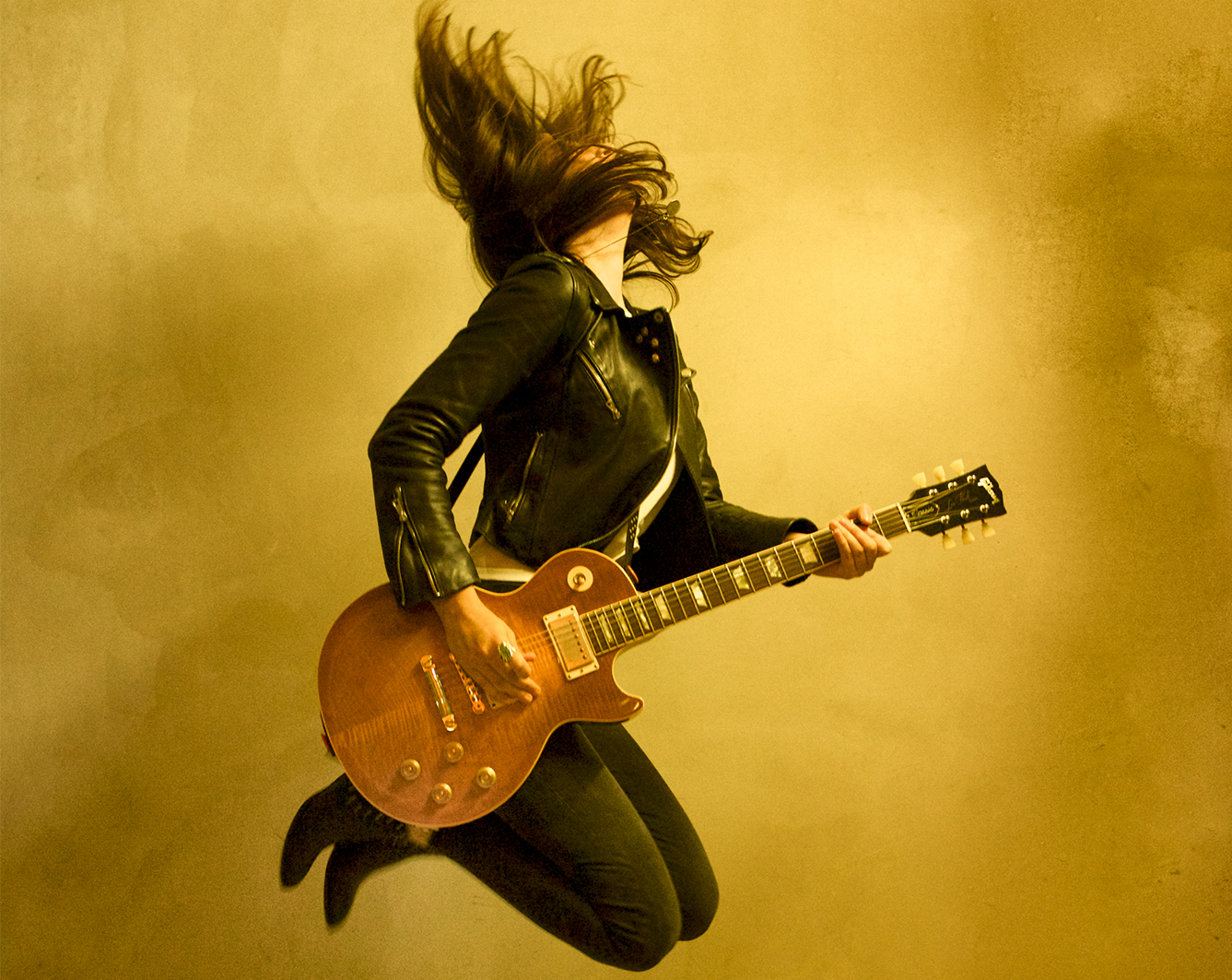Laura Cox on being a leftie playing right-handed and why she'd take a high-end Epiphone over a cheap Gibson
The maverick French hard-rocker talks Burning Bright, chicken pickin’ and why the YouTube comments section is not as terrifying as being onstage for the first time

Laura Cox is more fearless than she knows, having enjoyed a very modern baptism of fire via a series of YouTube videos that brought her formidable talents to the guitar community’s attention.
Besides a backing track and an electric guitar, she was flying solo, and facing down that comments section alone would thicken anybody’s skin.
But as Cox is sitting at Gibson’s London HQ, accompanied by a cornucopia of Les Paul ’59 reissues and rhythm guitarist Mathieu Albiac, with a two-month-old endorsement with Gibson already bearing fruit in the shape of a Les Paul Junior, and her recently released sophomore album, Burning Bright, it has all worked out OK.
Cox’s soloing style is flamboyant with a foregrounded melody front and center. She will reprise melodies used in the rhythm parts or vocals and use them again in a lead part.
Her vibrato is aggressive, her picking perhaps less so, but as she explains here this is all owing to her innocently picking up a right-handed guitar as a beginner and learning on that, unaware that she was a southpaw.
I naturally thought that my strong hand would be on the neck and it felt more natural that way
It’s an easy mistake to make when you are learning. But as Cox says, it’s too late to change now for her hybrid picking style, which sees her switch up flat-picked passages with kinetic chicken pickin’.
This puts her at a considerable advantage in that she has a playing style that’s all her own, one that lends itself to more melodic phrasing, and to integrating southern rock and country into a hard rock sound.
All the latest guitar news, interviews, lessons, reviews, deals and more, direct to your inbox!
Cox cites a number of influences, bluegrass through to hard rock, contemporary players such as Jared John Nichols and Tyler Bryant, and songwriters such as Sheryl Crow. The Laura Cox Band’s sound doesn’t sit still is by design, but you will find it somewhere between hard-riffing classic rock of the ‘70s and ‘80s and in the Americana of the southern rock scene.
Recorded at ICP Studios in Brussels, Belgium, and mastered by Howie Weinberg, Burning Bright sees Cox take a more expansive approach than on her 2017 debut, Hard Shot Blues, but as she explains, no matter where the song ends up, it all starts with a riff.
What were the sessions like for Burning Bright?
“When we got into the studio I already knew what we were going to do. We had already recorded preproduction. I like to be prepared. I already had all the songs.
My bass player and drummer, maybe they didn’t have every part in their head but they already knew the songs. And even the solos, I didn’t really improvise except on one song. I like to have everything in my head before going in.”
Which solo did you improvise?
“Freaking Out Loud. The solo is an improvisation because it was the only song we hadn’t finished before entering the studio. We were late and we finished the song during the recording process.”
Your solos always sound composed, but not overworked. How do you strike that balance?
“Maybe, I’ll change the way I work in the future but for now I feel more comfortable composing the solos before getting in the studio. When I started playing guitar, I was really into technical stuff. Now I am more into melodies and paying attention to melodies.
"Like you said, sometimes I pick up parts from the vocal and try to translate them into my solos. But that is not something I think about when I play the guitar; I just record a backing track and then try to find some ideas, jamming on it over and over again, and then I’ll record it, and then I listen to it, think, ‘Ah! I like this part, and this part.’ I reassemble all the parts that I liked and try to make my solo from that.”
You want every part to be doing something. Solos are a great way to change the energy in the song.
“Yeah, sometimes we include faster instrumental parts. There’s a song on the album, As I Am, and it’s a mid-tempo song but at the end we have the second part, which is just instrumental and solos, and it’s faster, twice the tempo than the first part, and, yeah, I think it adds something to the song. Sometimes it creates a different atmosphere. It can lead somewhere else.”
Rock music needs those dynamics.
“We tried to think about that more on this album than our previous one, which I think lacked dynamics. We had songs at the same tempo, same key, and on this album we tried to seek a different atmosphere.
“You can have softer songs with a southern [rock] edge, and then you go back and the song before will have a harder edge. We try to create different atmospheres and take the audience with us on this musical trip.”
What guitars did you use on the album?
“I used my Bacchus. I use that a lot on stage but also in the studio. I mostly use the same gear as I do onstage; my Bacchus Duke, my Gibson Les Paul Classic. I used a Firebird Standard for two or three songs, a Fender [American Vintage] ’52 Telecaster for two songs, the southern-sounding songs.
“And I played some really easy lap steel parts on a few songs. For the amps, I used what I use live, my main amp, an Orange Rockerverb 50. I used some cabinets that were in the studio because they had the same as I have but only the vintage versions and it sounded better – a 4x12 Orange cab.
“Mathieu let me play one of his Marshall JMP 2103 combos. [Mathieu: ‘She played on it for a few days and then the amp was dead.’]”

What about effects? Your tone is pretty darn raw.
“Yeah, I didn’t want to use too many effects. I wanted to sound like the sound we have onstage. It was almost the same pedalboard that I use live, except I used a Dunlop Mini Fuzz Face Bonamassa. It was great for some songs.
My right hand is kind of weak, so I like to use chicken pickin'
"Other than that, it was my J. Rockett Archer, my SoloDallas Storm, and a delay by Anasounds, and I got to use a few vintage pedals from the studio. I don’t remember exactly the name. But I got to use a vintage Uni-Vibe and an MXR Octave Fuzz.”
Is there an essential on your pedalboard?
“The J. Rockett is my favorite overdrive pedal. That’s the one I use every time I have a lead part. This works really good for me.”
And you don’t have much modulation at all?
“I used the Uni-Vibe for a short solo, but other than that I don’t really like chorus effects. I prefer a little delay but other than that it’s just the amp and the guitar.”
You explained earlier that your songwriting always starts with the riff. Who would you consider the master of the riffs? Who has the biggest influence on yours?
“The masters of riffs, for me? I think it would be the same for myself and Mathieu, it would be Malcolm Young. Yeah! [Mathieu: “Both of the Young brothers!”] Because for us, AC/DC is the base and the core of every rock band.”
Good choice. It’s his right hand. It’s a hammer and it’s always on time.
“Not like mine! Yeah, that’s something I want to work on because I am a leftie playing a right-handed guitar.”
Like Mark Knopfler?
“Yeah, and I think that’s why my right hand is kind of weak. So I like to use chicken pickin. It feels better for me. That way I don’t have to move my hand really fast and I can just use my hand and my fingers at the same time and play fast without moving. But I don’t have a hammer for a right hand.”
Was it just the availability of left-handed guitars that made you play this way?
“No. It felt natural when someone handed me my first guitar. I naturally thought that my strong hand would be on the neck and it felt more natural that way, but maybe I should have tried the other way. I don’t know. But like you said, it’s too late! [Laughs] No, no, but it felt good that way, and I think half of the lefties are playing right-handed. A lot of people are doing that.”

It’s understandable in the case of Knopfler, who couldn’t get a left-handed instrument.
“And Joan Jett, she plays like this. Jared James Nichols also. But it wasn’t even a decision; I never thought about it. It was just the right way to do it.”
That must give you something different?
“I don’t know. Maybe my left hand is stronger so I tend to focus on my left hand more and it gives me a particular feel that is different.”
Having that hybrid picking style opens up all kinds of musical possibilities.
“Yeah, it leads you to other things that maybe you wouldn’t have the idea for if you were playing with just a pick. I have a way of playing and I can’t play like a hammer.
"And I am a girl. I have a different sensibility. I like playing with my fingers, and chicken pickin’ suits me well.”
Do you remember the guitar you started on?
I was watching a lot of American Idol, so I just wanted to sing and play acoustic guitar
“It was a cheap classical guitar that my aunt gave to me. I played on this guitar for just a few weeks and then I got my first acoustic guitar - a cheap one too - and then I think, after six months, I realized I wanted to play the electric guitar.
"So I went out and my mother bought me a Squier Showmaster. I think it had three pickups, two single-coils and a humbucker - or two humbuckers and a single-coil in the middle? It wasn’t a good guitar, with a small Fender amp, but I learned with that guitar.”
There’s something to be said for learning on an uncooperative instrument.
“I think so, because that way you can appreciate it more when you have really good guitars that you have wanted for so long. I have some friends who have money and they bought themselves a real Gibson Les Paul for their first guitar, and it’s great, but you don’t realize what you are playing, what you have, and maybe the fact that you start on a cheap guitar, it’s not easy to play, and so it makes you practice more and really appreciate it when you get a better one.”
We must ask you about YouTube, because you really built a following on there first. Was that not terrifying?
“On the contrary. I would say that being on YouTube was easy because I just recorded things at home.
“But when I got to go out and play onstage, that was terrifying, because I had spent the first eight years of playing guitar just recording videos at home alone. It was very comfortable for me, and then I met Mathieu and he told me that we have to get out and play with real musicians and that is when I got scared.”
Did you always want to play rock? What were you listening to when you started playing?
I don’t really play acoustic guitar anymore. Now I’m really a Les Paul girl
“[Laughs] At the time I had several things in mind. I was watching a lot of TV shows we have in France, like American Idol, things like that, and so I just wanted to sing and play acoustic guitar.
"Then I don’t know if there was a specific moment when I decided to pick up the electric guitar, but I guess it is because I met some friends in high school, and I started listening to rock music.
"That’s when I discovered Guns N’ Roses and Dire Straits, and I thought to myself that I wanted to play this solo and this riff, and then I got my first electric guitar.”
And that’s like entering a whole different world.
“It’s not the same [again]. Now, I don’t really play acoustic guitar anymore. I’m really a Les Paul girl.”
Gibson just gave you an LP Junior.
“Yeah, and I am really happy with it. I had never tried Les Paul Juniors before, and they handed that one to me when we were at the Gibson showroom in Paris. It felt really good.
"I love Telecasters and I had the feeling that this one was kind of a mix between a Les Paul and a Telecaster. It is simpler than a Les Paul. You only have one pickup, two knobs, and it’s light, with a big chunky neck. You are not afraid to beat it. I absolutely love this guitar.”
You prefer a clubbier neck?
“Yeah, I also have a Gibson Les Paul Classic and it has a thinner, tapered ‘60s neck, and I love that guitar, the neck is really easy to play, but I don’t feel it’s that comfortable because my Bacchus had really big necks and I got used to that. I like a ‘50s neck, and I am really happy with the profile of the neck on this Junior.”
Have you had other Les Pauls? What else have you played?
“After that Squier I bought a Fender Classic Player ‘60s Stratocaster. I think I bought it because of Mark Knopfler, but then I got into Slash and wanted a Les Paul. It was my first real guitar but I can’t say it was good because I made the mistake of buying on the internet.
"I didn’t really know what I was buying, and it was a mistake because the action was really high, the setup was messy, and I didn’t really feel comfortable. I sold that, got an Epiphone Slash [Appetite Les Paul Standard]. It has the Seymour Duncan Alnico humbuckers.”
You can record with that. That’s an excellent guitar.
“High-end Epiphones are great. I think it is better to have a high-end Epiphone than a cheaper Gibson. At the time, it cost €700 [approx. $780], and you’ve got the hardcase, the Seymour Duncans, the long-tenon neck. It was a great guitar and I wouldn’t sell it. Now I’ve got several Gibsons, but I am keeping that one.”
Jonathan Horsley has been writing about guitars since 2005, playing them since 1990, and regularly contributes to publications including Guitar World, MusicRadar and Total Guitar. He uses Jazz III nylon picks, 10s during the week, 9s at the weekend, and shamefully still struggles with rhythm figure one of Van Halen’s Panama.

